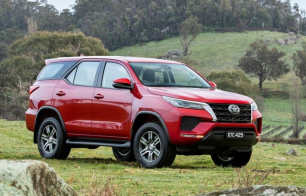The CX-90 is enormous, but despite its long bonnet, it feels on the inside like it makes good use of its dimensions.
Up front, it’s easy to find a seating position thanks to an array of adjustability, from the seats to the telescopic adjust for the wheel, and the cabin is wide and tall enough to accommodate pretty much anyone with ease.
Unlike some Mazdas which have a strange zoom-factor on their rear vision mirrors, the CX-90 doesn't have this problem, and visibility generally out the windows is impressive. I can see the long, tall bonnet and cosy dash design creating visibility issues for shorter drivers, however.
Padded materials are everywhere they should be (and more), and when it comes to storage there’s a large bottle holder in each front door, two more cupholders in the centre console (with a flip-out cover), a split-opening centre console box (which hides USB-C connections, great for cable management) and a wireless charging bay up front below the climate unit.
It’s rare these days to see a full array of physical buttons and toggles for a dual-zone climate set-up, but the Mazda has the whole lot. It’s a breeze to adjust on the fly and integrates into the design in a subtle way.
It’s also worth calling out the multimedia screen isn’t a touch unit. Instead, you need to control it through a handful of buttons and a rotary dial on the centre console. It’s nice to have a physicality to it, and it works well for the relatively simple base operating system, but it’s a clumsy way to interact with phone mirroring.
In my experience Apple CarPlay has simply too many icons and menu features to work around with a dial-operated system, to the point where it’s distracting to use on-the-go (thus, defeating the purpose of having physical controls).
The second row is a real highlight. Set to its default position, I have leagues of legroom behind my own driving position (at 182cm tall). Again, heaps of width and headroom here, and even the huge rear doors open nice and wide, which should make loading luggage and fitting child seats easy.
The seat trim is just as good as it is in the front, with decent side bolstering, and top-notch amenities, with shades built into the windows, decent-sized bottle holders in each door, a further two in the drop-down armrest, soft pockets on the backs of each front seat, and a separate climate zone with independent temperature and fan speed controls.
There are two adjustable air vents with a lock-off, as well as two USB-C ports for power. Top marks.
The third row is usually where things get tricky for SUVs like this, but the CX-90 isn’t out of tricks yet.
Access isn’t the easiest. The second row can fold forward, but the left over aperture for clambering in, even though the doors are quite large, isn’t great, which will make it a no-go for anyone with mobility issues.
However, once you’re back there, I was surprised to find a full-sized adult like me can fit in relative comfort. With the second row set as far back as it can go, my knees are hard up against the back, but when rolled forward for more third-row space, there's still plenty of room in the middle. I was left with ample room for my knees and feet in the back seats. The seat trim also offers decent padding and comfortable trims, which is rare for most three-row SUVs, and while you wouldn’t want to be too much taller than me, the roof was just tall enough to have a little airspace above.
The armrests are hard plastic, unfortunately, but offer two large bottle holders on each side, as well as a USB-C port, and vents with decent air flow, which is again, quite rare for a three-row SUV.
I’d go so far as to say this is one of the best SUV third rows I’ve been in when it comes to space, comfort and amenity.
Now for the luggage space. I was pleased to find, even with the third row up, I could fit the largest (124 litre) CarsGuide luggage case with room to spare on either side. Officially, space here is 257L, but it’s rare to fit a case this size in a three-row SUV.
With the third row folded down, space comes in at 608 litres, which is on-par for this segment, and with the second and third row down, it tops out at 2025L.
With such space on offer it’s probably worth keeping in mind the payload, which is 580kg, and for those who want to add a trailer to the mix, the maximum towing capacity is 2500kg braked or 750kg unbraked for the 50e petrol straight-six versions like the one we’re testing here.

